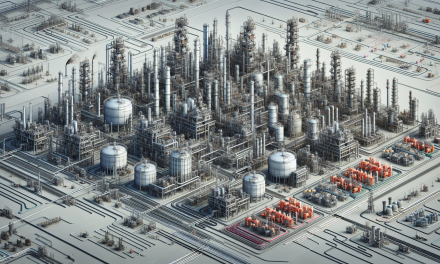Table of Contents
- Introduction
- What is Gas Chromatography?
- Importance of Gas Chromatography in Oil & Gas
- How Gas Chromatography Works
- Common Issues in Gas Chromatography
- Troubleshooting Techniques
- Best Practices for Gas Chromatography
- FAQs
- Conclusion
Introduction
Gas chromatography (GC) plays a pivotal role in the analysis and quality control of materials in the oil and gas industry. From determining the composition of hydrocarbon mixtures to ensuring compliance with environmental regulations, gas chromatography provides essential data. However, challenges often arise in the process, necessitating effective troubleshooting strategies.
What is Gas Chromatography?
Gas chromatography is a powerful analytical technique used to separate and analyze compounds that can vaporize without decomposition. This method involves a sample being injected into a chromatograph, where it is vaporized and transported by a flow of inert gas through a column filled with stationary phase material. Depending on their interactions with the stationary phase, the different components of the sample will exit the column at varying times, a phenomenon known as retention time.
Importance of Gas Chromatography in Oil & Gas
In the oil and gas sector, gas chromatography is crucial for several reasons:
- Quality Control: GC helps ensure the quality of crude oil and refined products by identifying impurities and excess hydrocarbons.
- Environmental Compliance: Regular monitoring of gas emissions using GC ensures compliance with environmental regulations, thus protecting natural resources.
- Research and Development: Gas chromatography supports R&D efforts that rely on precise measurements of chemical compositions.
How Gas Chromatography Works
To understand how gas chromatography works, it is essential to detail its components and processes:
1. Sample Introduction
The first step involves introducing the sample into the GC system, usually via an injector. The injector vaporizes the sample and then rapidly introduces it into the column.
2. Column Separation
As the vaporized mixture travels through the column, different components interact with the stationary phase based on their physical and chemical properties. Consequently, this interaction leads to separation.
3. Detection
Once separated, the individual components exit the column and enter a detector, often a flame ionization detector (FID) or a thermal conductivity detector (TCD). The detector generates a signal corresponding to the amount of each compound.
4. Data Analysis
Finally, the data obtained is analyzed using specialized software, allowing technicians to identify and quantify the compounds present in the sample.
Common Issues in Gas Chromatography
Even experienced technicians can encounter various issues with gas chromatography. Knowing these problems upfront can help mitigate their impact:
1. Poor Peak Resolution
Peak resolution is crucial for accurate analysis. When peaks overlap, it becomes challenging to distinguish between compounds.
2. Baseline Noise
High baseline noise can give misleading results, making it difficult to perceive genuine signals.
3. Retention Time Variability
Variations in retention time can suggest inconsistencies in the process, leading to unreliable results.
4. Sample Degradation
If samples are not appropriately handled, they may degrade prior to analysis, skewing results.
Troubleshooting Techniques
When complications arise, applying effective troubleshooting techniques is essential. Here are some strategies:
1. Check the Injector
Regularly inspect the injector for blockages or leaks. Consider using a new liner or septum if issues persist.
2. Ensure Proper Column Condition
Monitor the column’s condition and replace it if you observe a significant drop in performance. Consider conditioning the column as required.
3. Optimize Flow Rates
Adjust carrier gas flow rates to achieve optimal separation. Generally, lower flow rates can enhance resolution.
4. Calibrate Equipment Regularly
Ensure that all equipment, including detectors and software, is regularly calibrated. This practice guarantees accurate measurements.
5. Review Analytical Methods
Periodically review the analytical methods in use. Techniques may require modifications to align with the latest best practices or troubleshoot persistent issues.
Best Practices for Gas Chromatography
Alongside troubleshooting, adopting best practices enhances the overall effectiveness of gas chromatography in the oil and gas industry:
1. Use High-Quality Standards
Always utilize high-quality reference standards for calibration. This practice ensures accuracy and consistency in analysis.
2. Implement Proper Maintenance Schedules
Establish a maintenance schedule for all GC equipment to prevent downtimes and operational hitches.
3. Train Personnel Continuously
Investing in employee training enriches knowledge in gas chromatography, aiding in better troubleshooting and operational efficiency. For instance, consider enrolling in the Gas Chromatography Troubleshooting in Oil & Gas Industry Course.
4. Document All Procedures
Thorough documentation aids in analyzing trends over time. Always document the methods, calibration curves, and any issues encountered.
5. Embrace Technology
Utilize software and automation tools for data analysis and equipment monitoring, which can significantly boost efficiency and accuracy.
FAQs
1. What are the applications of gas chromatography in the oil and gas industry?
Gas chromatography is widely used for quality control, environmental compliance, and research and development. It helps identify the components of hydrocarbon mixtures, ensuring their quality meets industry standards.
2. How can I troubleshoot poor peak resolution?
Poor peak resolution may stem from various issues, including column condition or flow rates. Check the injector for blockages and consider optimizing gas flow rates. Additionally, ensure that the column is properly conditioned and replace it if necessary.
3. What should I do if my sample degrades before analysis?
To prevent sample degradation, store samples properly in suitable containers and analyze them as soon as possible. Additionally, use appropriate preservation techniques for sensitive compounds.
Conclusion
Gas chromatography serves as an invaluable tool in the oil and gas industry, aiding in various crucial aspects, including quality control and environmental compliance. Although challenges can arise, understanding common issues and implementing effective troubleshooting techniques can ensure processes remain smooth and efficient. By adhering to best practices and continually optimizing processes, professionals in the industry can maximize the benefits of gas chromatography. If you want to deepen your expertise further, exploring the Gas Chromatography Troubleshooting in Oil & Gas Industry Course could be beneficial.
For those interested in the broader context of energy generation, consider reading about Understanding Power Generation: A Comprehensive Guide to Steam Turbines, Gas Turbines, and Combined Cycle Power Plants, or delve into Unlocking the Secrets of Oil & Gas Marine Terminal Operations. You may also explore ways to improve operational efficiency with Maximizing Efficiency in Refinery Processes: Techniques for Yield Optimization, and gain insights into Mastering Petroleum Refining: Strategies for Production Planning, Scheduling, and Yield Optimization. Finally, elevate your industry expertise by discovering more about the Mini Master in the Petroleum Industry Training.





